

Giannicola di Paolo, who was born in Perugia, was first documented on 1484. He served as a Prior of Perugia in 1501, which suggests that he was a prominent member of the Arte dei Pittori (Artists’ Guild) by that date. His ownership of a workshop in Piazza del Sopramuro (now Piazza Matteotti) is documented in 1509-33.
A series of surviving documents (see the paper by Dr Sheri Shaneyfelt, referenced below) relate to payments made to him in 1493 for "certain figures" that he had painted for the Oratorio di San Pietro Martire, and for work in the chamber of the Capo d’ Ufficio in Palazzo dei Prior, but these works have been lost. His earliest surviving documented work, which dates to 1493, was in the refectory of the Palazzo dei Priori (see below).
Giorgi Vasari includes Giannicola di Paolo among the disciples of Perugino, and it is likely that he was associated with Perugino’s workshop in Florence before 1493 (see below). Vasari lists three of his works (below), all of which are documented:
-
✴the decoration of the Cappella di San Giovanni Battista in the Collegio del Cambio; and
-
✴two works that are now in the Galleria Nazionale:
-
•the Pala dell’ Ognissanti from San Domenico; and
-
•an altarpiece of Christ in the Christ in the Garden of Gethsemane from San Francesco al Prato.
Perugia: Galleria Nazionale
Last Supper (1493)
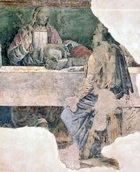
As Dr Sheri Shaneyfelt (referenced below) has established, the fresco in Perugia seems to have been modelled on another of this subject in the Convento di Sant' Onofrio, Florence which is usually attributed to Perugino and dated to the period 1485-93. As noted above, it is possible that Giannicola di Paolo was associated with Perugino in Florence at the time that this (probably) earlier fresco was painted.
Crucifixion (1501?)
This fresco was detached from the wall behind the altar of the Oratorio di San Domenico in the 18th century. It entered the Galleria Nazionale in 1878 and was transferred on to canvas in 1947. It depicts the monumental body of Christ on the Cross, and is set in a landscape.
The fresco has traditionally been associated with the work that was the subject of a payment by the Confraternita di San Domenico to Giannicola di Paolo in 1501. However, this attribution remains a matter for debate. For example, the work has also been attributed to Pompeo Cocchi. The date has also been called into question, not least because the landscape seems to be based on that in the Adoration of the Magi (1504) by Perugino in the Oratorio di Santa Maria dei Bianchi, Città della Pieve.
Crucifixion (early 16th century)
This fresco, which was detached from the wall of the Prior’s apartment in the Abbazia di San Severo in 1863, is attributed to Giannicola di Paolo. It is now in the deposit of the Galleria Nazionale.
Blessed Colomba da Rieti (ca. 1505)
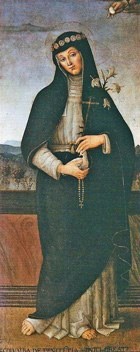
The panel depicts the Blessed Colomba standing on a terrace set in a landscape. She holds a dove, a rosary, a small wooden cross and a lily. The hand of Jesus appears in the top right hand corner, offering her the Host. The inscription along the bottom that identifies her seems to be a later addition.
Pala dell’ Ognissanti (1506-7)
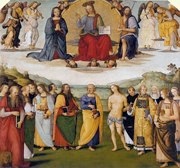
This altarpiece (of All Saints) by Giannicola di Paolo was commissioned for a chapel in San Domenico according to the terms of the will (1493) of Margherita della Corgna, the wife of Baglione di Ugolino dei Montevibiani. Giorgio Vasari recorded it in situ in the 16th century. Although the altarpiece was listed among the works to be sent to the Musei Capitolini, Rome in 1812, it was subsequently decided that it should remain in the church. It entered the Accademia di Belle Arti in 1810 and was subsequently moved to the Galleria Nazionale.
In the upper part of the altarpiece, Christ appears in glory in a mandorla between the Virgin and St John the Baptist, with pairs of musical angels to the sides. A number of saints witness the scene from below: those that can be identified include SS Jerome, Nicholas of Bari, John the Evangelist, Paul, Peter, Sebastian, Peter Martyr, Stephen, Catherine of Siena and Mary Magdalene.
Santi Quattro Coronati Altarpiece (1506-12)

The “Maestri Lombardi di Pietra e Legname” (the guild of Lombard stone masons and carpenters) commissioned this altarpiece from Giannicola di Paolo for the Cappella dei Lombardi in Santa Maria dei Servi in 1506. It was installed in 1512 and moved to their new chapel in Santa Maria Nuova in 1540.
-
✴The main panel depicts the Madonna and Child enthroned with the “quattro coronati” (four sculptors martyred by the Emperor Diocletian when they refused to sculpt statues of idols). Dominique-Vivant Denon selected the main panel for confiscation after the Napoleonic suppression of 1810 and it remains in the Musée du Louvre, Paris.
-
✴The predella panels (illustrated above), which remained in Perugia and subsequently passed to the Accademia di Belle Arti and then to the Galleria Nazionale. They depict:
-
•SS Herculanus and Constantius;
-
•three scenes from the martyrdom of the “quattro coronati” (four crowned saints); and
-
•SS Bernardino and Sebastian.
Panels from a polyptych (ca. 1510)
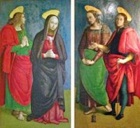
-
✴St John the Evangelist and the Virgin; and
-
✴SS Mary Magdalene and Sebastian.
All the figures are grieving, so they probably flanked a Crucifixion or perhaps a Pietà.
Madonna della Pergolata (1446-7, restored 1519)
Giannicola di Paolo restored this important altarpiece by Giovanni Boccati in the Oratorio di San Domenico in 1519. It entered the Galleria Nazionale in 1863.
Christ in the Garden of Gethsemane (1530-2)
Antonio di Luca commissioned this altarpiece in 1530 for his chapel (the Cappella di San Luca) in San Francesco al Prato, and he made the final payment for it in 1532. This is one of three works by Giannicola di Paolo cited by Giorgio Vasari. It was recorded in the early 19th century in the Oratorio di San Bernardino, by which time it was badly damaged. It entered the Galleria Nazionale in 1810.
Incredulity of St Thomas (1530s)
This altarpiece, which is attributed to Giannicola di Paolo and dated on stylistic grounds to the 1530s, came from the Monastero di San Tommaso. It was on the high altar of the church until 1879, when it moved to the Galleria Nazionale. It depicts the risen Christ standing in a landscape, while St Thomas examines the wound in His side and St John the Evangelist records the scene for his gospel. To the right, SS George, Benedict and Antony Abbot look on. The figures of SS Dominic and Antony Aquinas to the left were added later, almost certainly after 1555, when the nuns were transferred from the Cistercian to the Dominican Order: they possibly replaced an original figure of St Bernard of Clairvaux, the Cistercian founder.
The altarpiece was replaced by a copy (1881) by Ludovico Caselli, which the nuns took with them when they moved to the Monastero della Beata Colomba in Corso Garibaldi. It is now on the left wall of the church there.
Adoration of the Magi (1545)
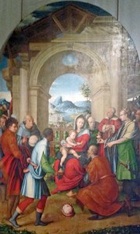
The work was subsequently split into two panels:
-
✴the Visitation; and
-
✴the Adoration of the Magi (illustrated here).
The predella, which had an inscription bearing the date, was subsequently lost.
The two main panels then went their separate ways:
-
✴Dominique-Vivant Denon, the Director of the Musée Napoleon selected the Visitation for confiscation after the Napoleonic suppression of 1810, and it is still in what is now the Musée du Louvre, Paris.
-
✴The Adoration of the Magi remained in Sant' Agostino until 1863, when it entered the Galleria Nazionale.
Perugia: Other Locations
Gonfalon (1494)
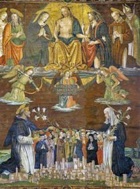
The altarpiece depicts SS Dominic and Catherine of Siena protecting Perugia from the arrows of angels. Above, Christ sits in judgement, flanked by the Virgin and SS John the Baptist, Sebastian, Andrew, Laurence and (probably) Herculanus. Perugia is represented by a group of citizens and a fine cityscape, The female Dominican in prayer, to the left of St Catherine of Siena (i.e. on the saint’s right), probably represents the Blessed Colomba da Rieti.
This banner has traditionally been attributed to Giannicola di Paolo, but it has been more recently attributed to Fiorenzo di Lorenzo or perhaps to someone in his circle.
Cartoons (ca. 1494)
The furniture on the right wall of the sacristy of the Duomo was commissioned from Mariotto di Paolo Sensi, il Terzuolo in 1494 and he was paid for the work in 1497. The cartoons for the carvings of SS Herculanus, Peter, Paul and Constantius are attributed to Giannicola di Paolo.
Work in Collegio del Cambia (1509-28)
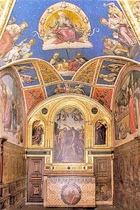
The commission began with:
-
✴a fresco (1509) on the exterior of the chapel, which subsequently deteriorated; and
-
✴the frescoes (1511-5) in the vaults, which depict God the Father with the Evangelists, the Apostles, the patron saints of Perugia and the Doctors of the Church.
Giannicola was then commissioned to complete the decoration of the chapel in 1515. This work was protracted and involved a series of disputes between the guild and the artist. The work was finally completed in 1528; the final payment was made after a process of arbitration in the following year. This final, protracted stage of the commission comprised:
-
✴the frescoes of scenes from the life of St John the Baptist, on the walls; and
-
✴the altarpiece of the Baptism of Christ, with smaller panels of the figures of the Annunciation to the sides.
Panels (1514)
Four [documented?] panels by Giannicola di Paolo survived when the organ screen of the Duomo was demolished in 1784. They comprise:
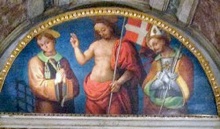
-
✴a lunette depicting the Risen Christ with SS Laurence and Herculanus, which is now above the altarpiece of the Cappella del Gonfalone there; and
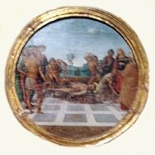
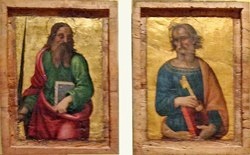
-
✴three panels that are now in the Museo Capitolare:
-
•a tondo of the martyrdom of St Lawrence, dated by inscription; and
-
•panels of SS Peter and Paul.
Work in San Pietro
Giannicola di Paolo is documented at San Pietro in 1500, when he was at work near the high altar. He was documented in 1509 at work in two chapels:
-
✴a chapel that belonged to Donna Leonarda Olivieri Baglioni (now known as the Cappella Ranieri), in which he worked with Eusebio di San Giorgio; and
-
✴the Cappella dei Re Magi [where was this?].
Portal (ca. 1475)
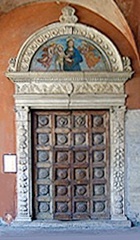
Frescoes (1519)
The damaged frescoes of the Cappella della Nunziata (now Cappella Vibi) of San Pietro, which are attributed to Giannicola di Paolo, were commissioned in 1519 and finished by Giovanni Battista Caporali in 1521. This work included the fresco of the Annunciation in the lunette above the altar.
Madonna delle Grazie (ca. 1515)
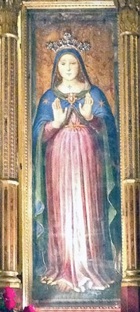
This panel has traditionally been attributed to Giannicola di Paolo, [but it has been more recently attributed to Perugino ??]
Madonna delle Grazie (early 16th century)
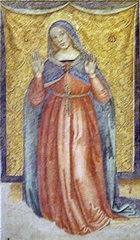
Madonna and Child with saints (16th century)
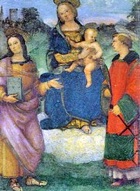
Foligno
Pietà (16th century)
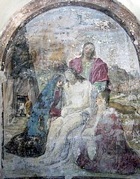
Spello
Giannicola di Paolo signed a contract for the altarpieces for two altars (1515) that Rocco di Tommaso da Vicenza built on the pilasters that flank the presbytery of Santa Maria Maggiore. This contract was never honoured, and the work was commissioned from the elderly Perugino in 1521.
Cartoon[s] (1530)
Andrea Campano da Modena carver the inlaid furniture (1524-30) of the sacristy of San Lorenzo. Giannicola di Paolo provided the cartoons for the figures of Noah, Moses and Zacharius.
Todi
Madonna and Child with saints (1516)
The altarpiece over the altar at the end of the navatina of the Duomo, which is attributed to Giannicola di Paola, was brought here in 1925 from the Abbazzia San Pancrazio di Collepepe outside Todi. It depicts the Madonna and Child with SS Catherine of Alexandria and Roch. The Pietà in the lunette has been effectively repainted, and the predella is lost. An inscription suggests that the repainting was done in 1631 at the request of Scipione d’ Elci, who was the commendatory abbot of San Pancrazio and governor of Spoleto at this time.
Read more:
S. Shaneyfelt, “A Reappraisal of Giannicola di Paolo's Early Career”, Burlington Magazine, 149 (2007) 39-42
C. Higgitt et al., “Working with Perugino: The Technique of an Annunciation attributed to Giannicola di Paolo”, National Gallery Technical Bulletin, 27 (2006) 96-110
E. Lunghi, “The Collegio Del Cambio in Perugia”, (2003) Assisi
P. Scarpellini (Ed.), “Il Collegio del Cambio in Perugia”, (1998 ) Perugia
G. Sapori, “Per un Riesame di Giannicola di Paolo”, Esercizi. Arte, Musica, Spettacolo, (1979:2) 57-63
V. Garibaldi, “Novità su Giannicola di Paolo: i Ritrovati Affreschi dell' Antico Refettorio del Palazzo dei Priori a Perugia” in:
P. Mercurelli Salari (Ed.), “Pietro Vannucci e i Pittori Perugini del Primo Cinquecento: I Lunedì della Galleria [Nazionale dell' Umbria]”, (1995) Perugia
Biographical information can be found on this page (2000) by Paola Mercurelli Salari of Trecanni.it.

